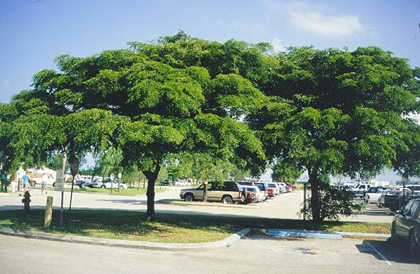Home > Pruning shade trees > Raising or lifting canopy > Raising the canopy - difficult decisions
Raising the canopy - difficult decisions

Before raising: The tree has never been pruned so there are many leaders growing from a short trunk. Branches are on the building and in the wrong position. Canopy is full of foliage and low to the ground. Clearance is needed for pedestrians and vehicles.

After raising: Large branches (14 inches diameter) were removed from the lower trunk. Pruning cuts of this size are damaging to the trunk causing severed disfunction and decay in some instances. This type of pruning also places most of the foliage high off the ground. Future growth occurs from the few stems that were left, and this growth will result in a taller and wider canopy. A taller and wider canopy is more prone to failure in a wind storm and under the forces of gravity. Allowing trees to grow to this point without pruning results in a tree form as seen above that is very difficult to work with. A better way to manage trees is to begin structural pruning when the tree is much younger to develop one trunk that grows straight up, and keep branches small compared to the trunk. This will allow you to removed these small branches as needed to clear the building. Removing the small branches will not be noticed as much as the pruning that resulted here, and the tree will be stronger. THIS TREE HAS NOW BEEN REMOVED DUE TO DECLINE AND POOR PERFORMANCE AT THE SITE RESULTING AT LEAST PARTIALLY TO THIS PRUNING TREATMENT.

Before raising: Shade trees not pruned early to suppress growth on low branches often develop large branches close to the ground that droop to get in the way of traffic.

After pruning: Large low branches had to be removed because they were not suppressed when the tree was younger. There is little option but to remove them at the trunk using large pruning cuts. Trees react poorly to cuts of this size, although they were required to create clearance,

